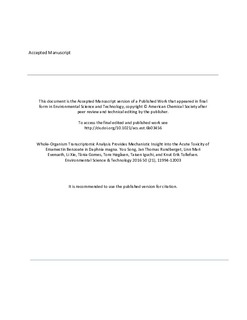| dc.contributor.author | Song, You | |
| dc.contributor.author | Rundberget, Thomas | |
| dc.contributor.author | Evenseth, Linn Mari | |
| dc.contributor.author | Xie, Li | |
| dc.contributor.author | Gomes, Tania | |
| dc.contributor.author | Høgåsen, Tore | |
| dc.contributor.author | Iguchi, Taisen | |
| dc.contributor.author | Tollefsen, Knut Erik | |
| dc.date.accessioned | 2018-10-05T09:07:54Z | |
| dc.date.available | 2018-10-05T09:07:54Z | |
| dc.date.created | 2016-12-20T20:41:38Z | |
| dc.date.issued | 2016 | |
| dc.identifier.citation | Environmental Science and Technology. 2016, 50 (21), 11994-12003. | nb_NO |
| dc.identifier.issn | 0013-936X | |
| dc.identifier.uri | http://hdl.handle.net/11250/2566614 | |
| dc.description.abstract | Emamectin benzoate (EMB) is an antisea lice chemical widely used in the aquaculture that may also unintentionally affect nontarget crustaceans in the environment. Although the adverse effects of this compound are well documented in various species, the full modes of action (MoAs) are still not well characterized. The current study was therefore conducted to characterize the MoAs of EMB and link perturbations of key toxicological pathways to adverse effects in the model freshwater crustacean Daphnia magna. Effects on molting and survival were determined after 48 h exposure to EMB, whereas global transcriptional changes and the ecdysone receptor (EcR) binding potency was determined to characterize the MoA. The results showed that the molting frequency and survival of D. magna decreased in a concentration-dependent manner, and the observed changes could not be attributed to direct interactions with the EcR. Major MoAs such as activation of glutamate-gated chloride channels and gamma-aminobutyric acid signaling, disruption of neuroendocrine regulation of molting, perturbation of energy homeostasis, suppression of DNA repair and induction of programmed cell death were observed by transcriptional analysis and successfully linked to the adverse effects. This study has demonstrated that acute exposure to intermediate and high pM levels of EMB may pose hazards to nontarget crustaceans in the aquatic environment. | nb_NO |
| dc.language.iso | eng | nb_NO |
| dc.publisher | American Chemical Society | nb_NO |
| dc.title | Whole-Organism Transcriptomic Analysis Provides Mechanistic Insight into the Acute Toxicity of Emamectin Benzoate in Daphnia magna | nb_NO |
| dc.type | Journal article | nb_NO |
| dc.type | Peer reviewed | nb_NO |
| dc.description.version | acceptedVersion | nb_NO |
| dc.source.pagenumber | 11994-12003 | nb_NO |
| dc.source.volume | 50 | nb_NO |
| dc.source.journal | Environmental Science and Technology | nb_NO |
| dc.source.issue | 21 | nb_NO |
| dc.identifier.doi | 10.1021/acs.est.6b03456 | |
| dc.identifier.cristin | 1415907 | |
| dc.relation.project | Norges forskningsråd: 160016 | nb_NO |
| dc.relation.project | Norges forskningsråd: 221455 | nb_NO |
| cristin.unitcode | 7464,20,13,0 | |
| cristin.unitcode | 7464,30,21,0 | |
| cristin.unitcode | 7464,20,17,0 | |
| cristin.unitname | Økotoksikologi | |
| cristin.unitname | Miljøkjemi | |
| cristin.unitname | Forskningsinfrastruktur | |
| cristin.ispublished | true | |
| cristin.fulltext | postprint | |
| cristin.qualitycode | 2 | |
